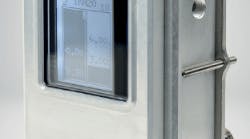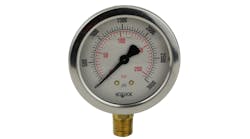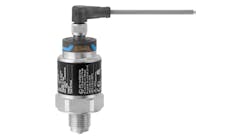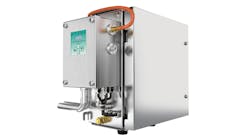Pepperl+Fuch's Bebco 7500 Series can purge, pressurize, monitor, maintain pressure and alarm on fault automatically, so problems can be detected and solved without unplanned shutdowns.
Pepperl+Fuchs designed the Bebco 7500 Series purge and pressurization system to take advantage of today’s technology.“Things are getting smaller, and people are more cost-conscious,” says Chris Romano, product portfolio manager at P+F. “Components are available that are less expensive, do as much or more, and take up less space. So, it became time to bring out a new kind of purge system.”
The system comprises a control unit, a pressure relief vent and a manifold air valve. The control unit features preset programs for most applications, and configuration can be completed in minutes via a touch display on the password-protected unit.
“With the touchscreen, we can put in a visual gauge like an HMI, and show pressure using a bar graph instead of having a magnehelic gauge," says Romano. "It’s like a smartphone compared to a calculator—we’re tapping into that technology.”
The control unit can mount on the panel or remotely, away from the enclosure.
“It can be AC- or DC-powered, and it’s universally certified, so gas analyzer and other OEMs can export it worldwide,” Romano says. “It mounts with a very small footprint—all it needs is a rectangular hole in the enclosure, where clamping it in with a seal gasket achieves NEMA 4X and IP65. It’s very easy for both end users and OEMs.”
The enclosure pressure is clearly indicated during and after purging.
“Most systems will let you know that it has pressure with an indicator, or will be limited on the range of pressure it can read. The 7500 indicates enclosure pressures from 0 to 10 in.w.c. (0 to 25 mbar) on the touch display in two ways—in digit form, and in analog form with a bar graph,” Romano adds.
A variety of vents are offered for different applications. Large enclosures initially need high flow to reduce purge time without using high pressures that might be too much for their large doors. Smaller enclosures that are well sealed or enclosures that use a special purge gas such as nitrogen call for better sealing and a lower flow rate—not flowing through a vent, but just pressurizing and compensating for leaks. There are also vents made of Delrin instead of metal, which cost less and resist chemicals.
Included relays can be used to energize the enclosure, activate an alarm or power an auxiliary system. The relays are rated TV-5 for constant current up to 5 A and inrush current up to 76 A, so no extra relay is required.
Users can select a manual or solenoid purge gas valve. The manual valve has both ball and needle valves—the ball valve for purge, and the needle valve to dial in the operating pressure. The solenoid valve is a ball valve, so purge flow can be automatic, then switched to a needle valve.
“To start the system, just power the 7500 unit and give it a purge source like air or nitrogen,” Romano says. “In case line pressure varies or unknown leaks occur, you can set internal pressure limits to turn on the solenoid valve to bump up the pressure,” Romano says. “You can set an alarm to tell you there’s a problem without shutting down the cabinet.”
Along with the display, there are LEDs for power, enclosure power and “pressure OK” visible from 50-70 feet, so operators can see status without going to the enclosure.
The 7500 is certified for Zone 2, 22 (Ex pzc) and Class I or II, Div. 2 (Type Z). It is cULus-listed, and has IECEx, ATEX and other global certifications for use worldwide.
“We extended the standard temperature range to -40 to 70 °C because more customers are specifying higher temperatures—over 60 °C—and temperatures below -20 °C,” says Romano.
“One unit does it all,” he adds. “Users can configure four pressure points in five selectable programs, and the same unit can be configured for both gas or dust. And it’s safe, because it can automatically reduce flow to prevent over pressure, alarm if the pressure is too low, and if needed, automatically compensate for excess leakages by increasing the flow.”
For more information, visit www.pepperl-fuchs.com.




